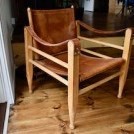-
Posts
104 -
Joined
-
Last visited
Contact Methods
-
Twitter
/
-
Instagram
@galjotin
Profile Information
-
Location
Slovenia
Player Profile
-
Age
30-39
-
Swing Speed
91-100 mph
-
Handicap
18
-
Frequency of Play/Practice
A few times per month
-
Player Type
Casual
-
Biggest Strength
Short Game
-
Biggest Weakness
Driver/Off the Tee
-
Fitted for Clubs
No
Recent Profile Visitors
2,304 profile views
Calvo90's Achievements

(1/14)
136
Reputation
-
My initial experience is the same. I still have to try ''chop down'' shot with the fairway wood when the ball is nestled in the rough but currently we are having too much rain. Winter is coming...
-
At the very last hole during the round of golf in Italian Alps I found myself on driveable straight 250 meter par 4. Tee box was elevated about 40 meters above the green and in order to drive the green you have to hit it blindly straight through the narrow window formed by 2 rows of spruces. My playing partners played the hole as the designer intended and layed up in the fat part of the fairway with long irons/hybrids whereas I hit my mini driver in hopes of hitting the green. First shot hook left into OB deep into brambles, barely missing the course employee that was bravely signaling the fate of each shot from the edge of the fairway. I re-tee with the Mini driver again and hit it pure. The ball flew high and landed straight on the green. The course employee said nobody in the tournament was stupid/brave enough to try that and my second shot that directly hit the green caught her completely by surprise. I set up behind the ball on the green in hopes to send the ball uphill, slightly sideways 20 meters over 2 tiers in hopes of saving bogey with 2 putts. Golf gods smiled upon me as I hit the first putt dead middle of the hole. I nearly p****d myself laughing as my playing partners were fuming and cursing as they all bogeyed the hole.
-
Recently I bought PING G425 7 wood just to experiment and compare against my 4 hybrid. Yesterday I put 7 wood in the bag for the first time. Despite the fact I hit my 4 hybrid usually quite well, 7 wood is in another league. As long I keep my tempo somehow manageable (which has recently been a struggle for me) the flight is high, straight (with the hosel on flat setting) and even borderline skulled shots somehow manage to get airbourne which is huge confidence boost for those shots over water, bushes in doglegs and onto elevated greens. I have to compare 4 hybrid and 7 wood from the rough but initial results are very promising. What are MGS forum members experience with 7 wood shots out of rough, especially compared to a hybrid?
-

Pulling Tip from BGT Stability Tour shaft
Calvo90 replied to ChitownM2's topic in Club Making/Repair & DIY Projects
It is notoriously difficult to pull a graphite shaft from metal golf club head (without the lever that shaft puller provides) because there is a fine line between the temperature that is usually needed to break down the epoxy that was used to glue the head to the shaft and the temperature at which the resin that holds the layers of graphite together starts to break down and cause the graphite shaft to delaminate. If pulling graphite shaft from metal golf head is considered expert job, pulling metal insert from BGT is God tier level stuff because the graphite is on the outside. You cannot use heat directly from the outside because the graphite portion of the shaft would delaminate before the heat would reach metal portion. Theoretically the only chance of pulling the metal portion of the shaft from BGT is to evenly heat up the metal portion of the shaft from the inside. Forget about heat gun or torch and don't even think about twisting. You would probably need something like a soldering iron with a long heated rounded end that would reach all the way into the metal shaft and while doing this somehow mount the shaft into shaft puller. I just don't see how this could be done with reasonable success rate and in reality I would expect to destroy the shaft in 99% of attempts. I would entertain the idea of using lathe. I would consider cutting the metal portion of the shaft at the end of BGT, mounting the graphite portion in the spinning vice (if that would be possible without breaking the shaft) and slowly either bore out the metal part or, if there is enough room, spirally turn the metal portion of the shaft from the inside. Epoxy would break as soon as the metal shaft would be punctured. Even in this case I would not expect this method to be reasonably succesfull and personally I would not even try it. -
I don't have any real data but that won't stop me from giving you my 0,02 USD. I would say wedge hardness has little to no impact on spin. As far as I understand modern wedge design, the spin is result of surface friction between the golf ball and non-grooved spaces on wedge face. Main objective of wedge grooves is ensuring that contact between the ball and wedge face is as clean as possible by hiding water, grass and other particles in the recessed areas of the grooves. That is evident from the fact that in perfect conditions (dry golf mat) non-grooved wedges spin the ball significantly more than grooved wedges and when you hit grooved wedge, the urethane from the golf ball in rarely wedged in the grooves but rather lioghtly coat the space between the grooves. Considering the fact that wedge grooves and groove edges don't produce (majority of ball spin) by gripping the ball and spinning it, I don't see how wedge hardness could have any effect on wedge spin, especially considering the fact that wedge designers have to respect the same rules when designing wedges, regardless if they design soft or hard wedge. I am ready for a pounding.
-
I am happy to make contribution to this topic I have been following for quite some time and think that brings out the best out of people. After close to 8 months of intense studying during state mandated temporary closure of non-essential businesses because of Covid, getting deep understanding of about 2 cubic meters of essential study material and exam that lasted 3 days I am happy to report that a few days ago I passed the bar - main law exam on my way to becoming a lawyer. Considering the situation approx. 700 km to the east I just hope that the time and energy I spent studying slovenian law was not in vain because I should have studied russian ''law''.
-
I know some OEM adjust weights to accomodate length changes on orders of new clubs but i wouldn't say that is necessary the case with other vendors. I would suggest measuring the swing weight yourself using at least internet swing weight calculator (like: https://www.hirekogolf.com/golf-clubfitting-assembled-swingweight-calculator) or preferably swing weight scale. Adjusting swing weight is simple: Just add 2g of weight to the club head to increase swing weight by 1 point but rather than going deep in the numbers i would suggest trying the club as is and in case it is too light or it overdraws, add 2g to the head and make a couple of swings again etc.
-
For me it is necessay to adjust swing weight with any changes of club length that exceed 0,25 inch. Adjusting swing weight can be done in a number of ways, some are simpler than others. I don't like tip weights because I prefer to add weigh somewhere behind strike point on the head hence I use shaft tip weights as a last resort when i don't want lead tape on the head (like in irons). For the purposes of testing I used lead tape because it is easier to add it and remove it on the go. Since I painted the lead tape and camouflaged it onto the clubhead i will probably leave it as is but I was also thinking about using Rattlestop to discretely add some weight inside the head through the weight port but that takes a bit more experience and caution because correcting mistakes is incredibly hard. The other option is also changing weights on the club. On Taylormade SIM Ti OG (like on many other clubs) there is single front weight that can be removed and changed for a heavier one. Stock weight was only 2g whereas it is possible to buy heavier weights in 2g increment up to 10 or 12g. I was worried that adding more weight toward the front of the club would reduce the spin too much and make my problems with shape even worse so I passed on this option.
-
-
Update on my experiment: I changed shafts and put 5 wood shaft in my 3 wood (Taylormade SIM Ti OG). I weighted both 3 wood and 5 wood head and put enough lead tape on the toe side of the V-sole to match 3 wood head weight to 5 wood head weight. Just to make it pretty I colored the lead tape with black sharpie so you have to really look carefully to see the lead tape. I played two rounds on the course and a couple of hours on tha grass field in front of my house. I am happy to report two things: First, I managed not to smash any of the house windows and second, my experiment worked as expected. Previously, at standard length I had to lower the loft on my 3 wood by at least 1,5 degrees to stop the ball from hooking, which made the club unusable from fairway. Now I can play the fairway wood at standard loft to play lovely baby fades from the fairway that are more than capable of holding the green and high straight ball from the tee which is unheard of for me. I even increased loft by one click which produced dead straight and high ball flight (even on mishits) from the fairway and 5 yard draws from the tee. Additional bonus is the fact that 3 wood sits lovely, flush to the ground, and even with just 1 inch of length difference the head looks even bigger which inspires even more confidence. Before I cut down the shaft on my 5 wood I will play a bit more golf to get more data and give the golfing gods enough time to show me any problems I have not yet noticed. Regardless I am exstatic with the results and recommend this experiment to anyone who is struggling with overhooking their fairway wood.
-
Thank you for advice. May I ask what length fairway wood shafts are you playing? Gripping down does not feel the same to me but luckily shafts in my 3 and 5 wood can be swapped. What I will probably do is that I will put 5 wood shaft into 3 wood, which is 1'' shorter, put appropriate amount of lead tape on toe of the club to keep the same swing weight and play with the club for a couple of weeks. That should give me more insight if cutting down works as should on the paper.
-
Hello everyone, I was wondering: Shorter driver lengths are quite common and topic of cutting down driver to obtain more control without sacrificing much of the distance (if any) has been debated ad nauseaum both on forums and on youtube. The results are clear and pretty much consistent across all testers (even MGS did a test a couple of years back). But when it comes to playing shorter fairway woods, I noticed there is little to no debate. I managed to found some on WRX forum but the debate seems to have stopped in paleolitic age. So I was wondering what MGS forum members' experience with shorter fairway wood shafts is? I am asking because I am seriously thinking about cuting down my 3 and 5 wood Taylormade SIM fairway wood for about an inch, so 3 wood (43,25'') would basically play at 5 wood length (42,25'') and 5 wood at 7 wood length (41,25''). I don't really seek better contact because I strike fairway woods pretty good, but because my tendency with fairway woods is to hit a draw, which has about 30% chance of turning into nasty hook off the tee or pull/draw off the fairway. Turning the loft on 5 wood on low setting which opens the face helps quite a bit but the downside is it turns 5 wood into 4 wood and not weak 5/6 wood I was hoping for. The main problem is with my 3 wood, which I cannot turn much lower because it is simply not functional off the fairway. When it comes to 3 wood I have to choose between standard loft setting with looming dreaded hook or lower settings which straighten my shots but lower my ball flight and turn my shots into devastating low spin smother hooks when hit on the toe of the club. If I didn't otherwise love my 3 wood I would simply get rid of it but I am convinced both of us can smooth out turbulent relationship and with a little adjustments have something special. I think shortening fairway wood shafts could be the solution to my problems. Shortening fairway wood shaft for 1'' would usually result in about 2° flatter dynamic lie angle (closer to 3° PING's flat setting), plus I would have to increase head weight with about 12g of rat glue I could position in the toe of the club to give it even more fade bias. These changes would theoretically made the woods more fade biased and allow me to play with higher lofts (14,25°-15° 3 wood and 18,25°-19° 5 wood) which would add more spin to the ball and more importantly mitigate dramatic curvatures on poor strikes. Any imput would be greatly appreciated.
-
Great idea. You can add me: @galjotin
-

Hosel, Shaft Sizes & Insert Depth
Calvo90 replied to fixyurdivot's topic in Club Making/Repair & DIY Projects
I understand, I was just trying to warn you about BBTG measurement. I found this relevant because when I bought +0,5 inch pulls from (I think) Mizuno irons and dry fit them into Srixons, they were only 0,25 inch longer than standard. I thought the seller measured them wrong but when I dry fit them in Mizuno head, the total measurement of the club was +0,5 inch as advertised despite the same hosel insertion depth. Reason for that was because of BBTG of Srixon irons was smaller than that of the Mizuno. http://image.slidesharecdn.com/shafttrimminginstructionsv5-090910085457-phpapp02/95/basics-of-golf-club-shaft-trimming-11-728.jpg -

Hosel, Shaft Sizes & Insert Depth
Calvo90 replied to fixyurdivot's topic in Club Making/Repair & DIY Projects
If I understood correctly your question you should be asking about BBTG measurement (bottom bore to ground measurement) to determine total length of the club (BBTG + shaft pull length equals total club length). BBTG info is near impossible to obtain from OEM and I have not really seen any info on the internet so the only way is measuring it yourself by removing one iron head. If you are interested about BBTG of Srixon irons I can measure my Srixon Z565 heads tomorrow.








